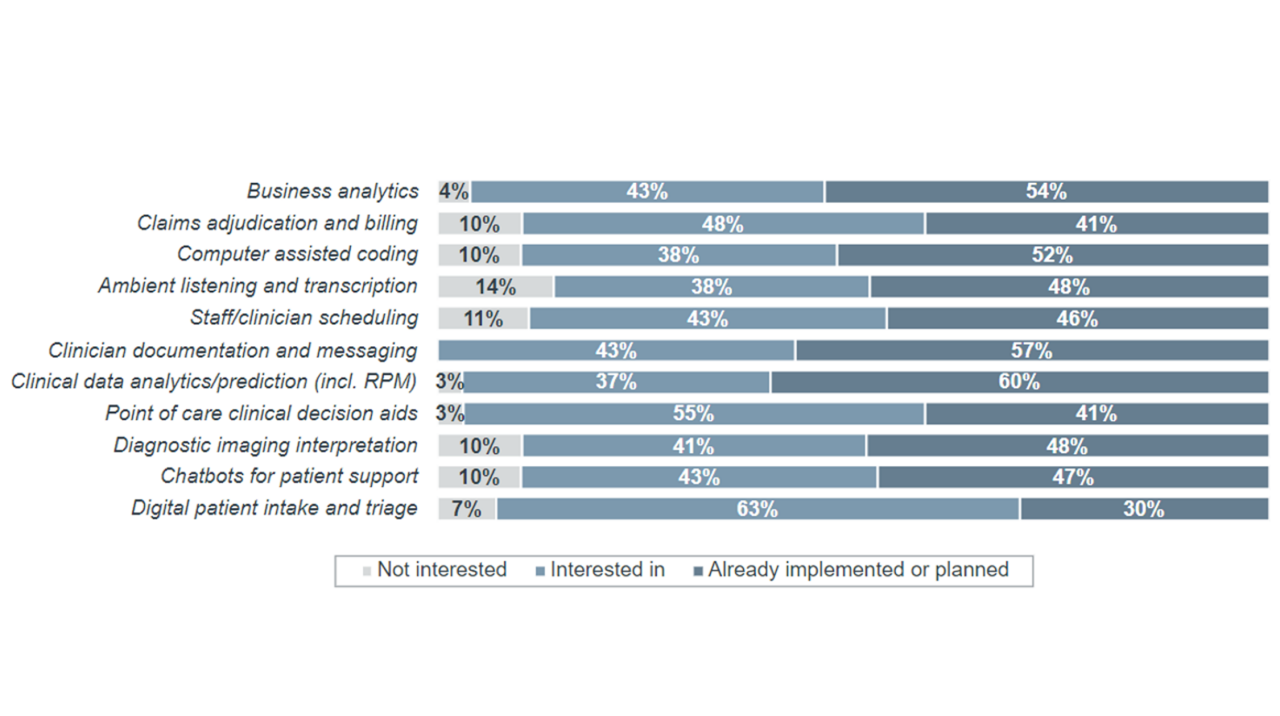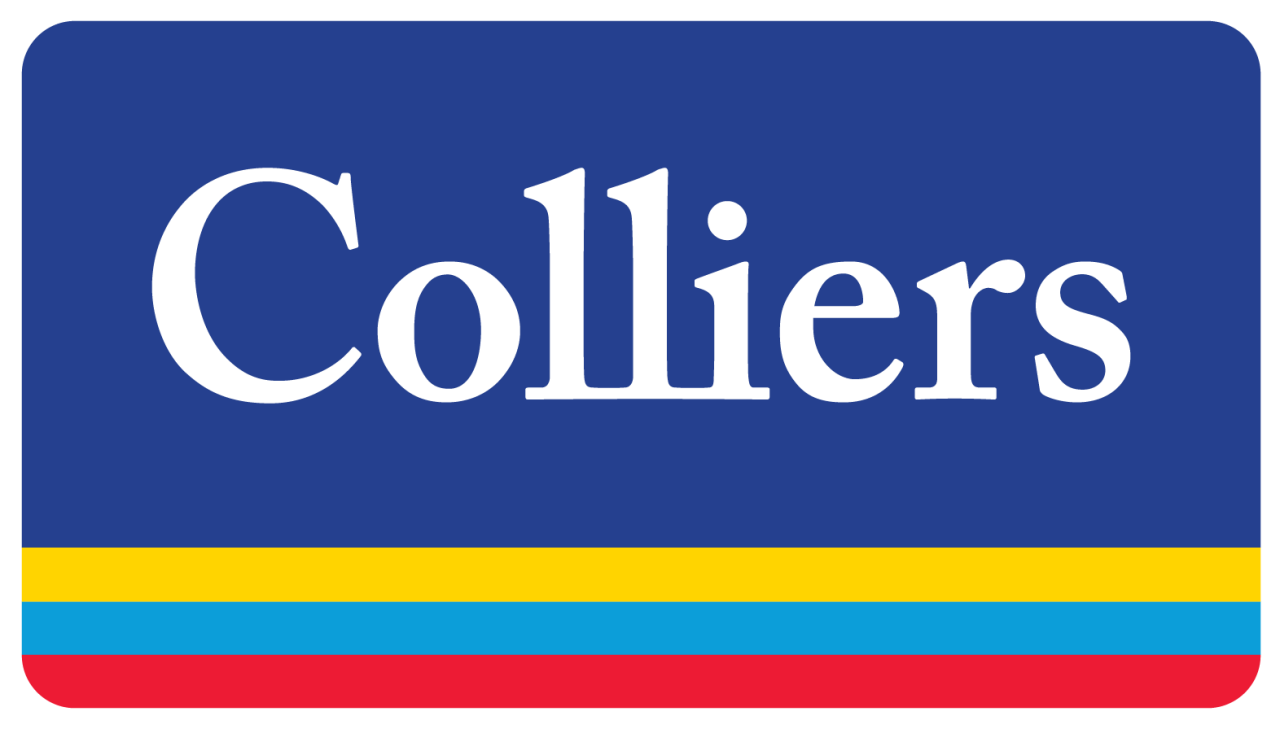Artificial intelligence continues to evolve at a rapid pace and promises to improve some of healthcare’s biggest challenges, including workforce burnout, quality patient outcomes, closing the gap in healthcare equity, and financial performance. We wanted to know how hospitals and health systems across the industry were reacting to this opportunity — and the hype — as they think about the future.
We surveyed 37 strategic planners from provider organizations and interviewed ten C-suite executives. The overall sentiment among these leaders is cautious optimism. In this brief, we highlight where leaders are focusing their efforts and identify four emerging themes on how they are approaching AI in healthcare.
Leaders are interested in AI across all aspects of care
There was overwhelming interest across all 11 solutions we asked about in our strategic planner survey. These solutions touch on nearly every aspect of provider organizations’ operations, including scheduling, triage, documentation, business analytics, and clinical decision-making.
The four areas where we see most health systems implementing AI solutions right now include: clinician documentation and messaging (100%), point-of-care clinical aids (97%), clinical data analytics and predictions (97%), and business analytics (96%).

However, keep in mind that leaders’ interest in these solutions could represent the availability of solutions, not the impact of them. The usefulness and return on investment for some of those solutions has yet to be determined and will ultimately depend on organizations’ needs and budgets.
C-suite leaders shared with us that they are optimistic about the potential of AI to improve healthcare efficiency and reduce costs, but they acknowledge that AI creates challenges for them — or exposes existing ones. In our interviews with C-suite executives, we identified four themes on how they are navigating the surge of AI in healthcare.
There are a lot of promising solutions on the market, but knowing where to start and what to choose might seem like a daunting task. To effectively incorporate AI, leaders must review their strategic plans, identify key challenges and goals, and evaluate their progress toward those goals. Doing so will allow leaders to pinpoint specific areas where AI can provide valuable assistance.
Within these areas, identify departments or individuals who are open to change and enthusiastic about leveraging AI technologies. Remember: it takes time to implement AI solutions. It’s not a process that can scale up immediately or evenly across use cases. Instead, it requires a gradual approach where you dedicate time to developing an evaluation, governance, and adoption strategy. Implementation over time — rather than trying to tackle everything at once — will be essential to sustain AI initiatives.
Because of the hype and availability of solutions, leaders explained that it’s been challenging to navigate the high-growth market and evaluate the number of available vendors. They specifically highlighted the increased need to develop better vendor evaluation tools.
Better evaluation could include using standardized intake forms or simply improving networking between CIOs. These tactics could ensure the AI solutions are not over-engineered for the needs of your healthcare organization and that they can easily integrate into existing systems.
Moving forward, it will become increasingly important for healthcare leaders to circle back to their problem-driven approach to evaluate AI opportunities for their organizations. A problem-driven approach streamlines the vendor selection process by focusing on the specific challenges and goals of the organization. It allows healthcare leaders to prioritize vendors with relevant expertise and solutions, engage in meaningful discussions, and consider factors beyond technology alone.
Because AI in healthcare is evolving rapidly, most healthcare leaders in our interviews agreed that AI solutions will eventually become a commodity. The real value will be in better data management.
Leaders will have to bring data evaluation frameworks to the forefront before investing. High-functioning AI solutions will require well-structured, unbiased, representative, and protected data. Standardized data testing and evaluation will be necessary to reduce discrimination and bias in AI solutions and promote better data hygiene.
The interviewees emphasized that a robust IT infrastructure and department are essential to help foster a culture of effective data management and education on data challenges. Enhanced AI literacy can increase the transparency of AI model training, the generalizability of the output, and a better understanding of the AI lifecycle.
The last major theme we’ve seen across our research is that we shouldn’t underestimate the value of moving slowly and purposefully. We need to adjust the way we see innovation and how fast we should move on new investments.
You can avoid overcomplicating your approach to AI by focusing on low-risk, high-impact use cases. The goal is that these use cases will have less data management, less scrutiny around bias and reliability, and more transparency. This could include use cases around healthcare transactions, where automation is relatively straightforward compared to the complexity of clinical data.
This incremental and thoughtful approach to AI will allow your organization to become more familiar with the technology. It will also allow you to create a solid foundation to implement more complicated AI use cases in the future. Most importantly, it will help keep your organization competitive and relevant in our ever-changing healthcare landscape.
2023 has been a breakout year for AI. Leaders see the potential for this technology to solve their top strategic priorities while also improving patient care. These priorities include workforce burnout, quality clinical outcomes, operational efficiency, and improved margins.
The principal areas we see health systems investing in — analytics and clinical documentation — especially reflect the need to address clinical burnout. Healthcare organizations can leverage AI-powered analytics to streamline, automate, and reduce the burden of clinical documentation processes. This gives healthcare professionals more time to deliver quality care by improving clinical outcomes and patient experience.
The success of AI moving forward will hinge on the ability to address these key issues. But also, leaders can’t think AI by itself will be a cure-all. To see meaningful change, they must adopt a problem-driven approach, revamp their vendor evaluation tactics, focus on data hygiene, and start with low-risk, high-impact use cases. Those who adopt this approach to AI will have a significant competitive advantage over those who have not.
Colliers is a leading diversified professional services and investment management company. With operations in 66 countries, our 18,000 enterprising professionals work collaboratively to provide expert real estate and investment advice to clients.
For more than 28 years, our experienced leadership with significant inside ownership has delivered compound annual investment returns of approximately 20% for shareholders. With annual revenues of $4.5 billion and $99 billion of assets under management, Colliers maximizes the potential of property and real assets to accelerate the success of our clients, our investors and our people.
Learn more at corporate.colliers.com, Twitter @Colliers or LinkedIn.
This expert insight is sponsored by Colliers, an Advisory Board member organization. Representatives of Colliers helped select the topics and issues addressed. Advisory Board experts wrote the report, maintained final editorial approval, and conducted the underlying research independently and objectively. Advisory Board does not endorse any company, organization, product or brand mentioned herein.
Don't miss out on the latest Advisory Board insights
Create your free account to access 1 resource, including the latest research and webinars.
Want access without creating an account?
You have 1 free members-only resource remaining this month.
1 free members-only resources remaining
1 free members-only resources remaining
You've reached your limit of free insights
Become a member to access all of Advisory Board's resources, events, and experts
Never miss out on the latest innovative health care content tailored to you.
Benefits include:
You've reached your limit of free insights
Become a member to access all of Advisory Board's resources, events, and experts
Never miss out on the latest innovative health care content tailored to you.
Benefits include:
This content is available through your Curated Research partnership with Advisory Board. Click on ‘view this resource’ to read the full piece
Email ask@advisory.com to learn more
Click on ‘Become a Member’ to learn about the benefits of a Full-Access partnership with Advisory Board
Never miss out on the latest innovative health care content tailored to you.
Benefits Include:
This is for members only. Learn more.
Click on ‘Become a Member’ to learn about the benefits of a Full-Access partnership with Advisory Board
Never miss out on the latest innovative health care content tailored to you.




